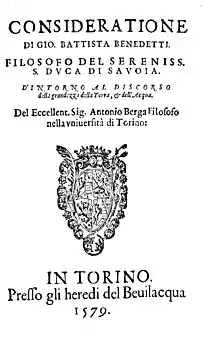Giambattista Benedetti
Giambattista (Gianbattista) Benedetti (August 14, 1530 in Venice – January 20, 1590 in Turin) was an Italian mathematician from Venice who was also interested in physics, mechanics, the construction of sundials, and the science of music.[1]

Giambattista Benedetti | |
|---|---|
| Born | August 14, 1530 |
| Died | January 20, 1590 (59 years) |
| Nationality | Italian |
| Scientific career | |
| Fields | Mathematician |
Science of motion
In his works Resolutio omnium Euclidis problematum (1553) and Demonstratio proportionum motuum localium (1554), Benedetti proposed a new doctrine of the speed of bodies in free fall. The accepted Aristotelian doctrine at that time was that the speed of a freely falling body is directly proportional to the total weight of the body and inversely proportional to the density of the medium. Benedetti's view was that the speed depends on just the difference between the specific gravity of the body and that of the medium. As opposed to the Aristotelian theory, his theory predicts that two objects of the same material but of different weights would fall at the same speed, and also that objects of different materials in a vacuum would fall at different though finite speeds.[1][2]
In a second edition of the Demonstratio (also 1554), he extended this theory to include the effect of the resistance of the medium, which he said was proportional to the cross section or the surface area of the body. Thus two objects of the same material but of different surface areas would only fall at equal speeds in a vacuum. He repeated this version of his theory in his later Diversarum speculationum mathematicarum et physicarum liber (1585). In this work he explains his theory in terms of the then current theory of impetus.[1][2]
It is thought that Galileo derived his initial theory of the speed of a freely falling body from his reading of Benedetti's works. Thus the account found in Galileo's De motu, his early work on the science of motion, follows Benedetti's initial theory as described above. It omits the later development which included the resistance of the medium and not just its density. In this early work, Galileo also subscribes to the theory of impetus.[3]
In 1572, the Jesuit Jean Taisner published from the press of Johann Birkmann of Cologne a work entitled Opusculum perpetua memoria dignissimum, de natura magnetis et ejus effectibus, Item de motu continuo. This is considered a piece of plagiarism, as Taisnier presents, as though his own, the Epistola de magnete of Peter of Maricourt and the second edition of Benedetti's Demonstratio.[4]
Music
In a letter to Cipriano de Rore dated from around 1563, Benedetti proposed a new theory of the cause of consonance, arguing that since sound consists of air waves or vibrations, in the more consonant intervals the shorter, more frequent waves concurred with the longer, less frequent waves at regular intervals. Isaac Beeckman and Marin Mersenne both adopted this theory in the next century. In the same letter, he proposed a measure of consonance by taking the product of the numerator and the denominator of a rational interval in lowest terms. James Tenney also used this method to develop his measure of "harmonic distance" (log2(ab) is the harmonic distance for the ratio b/a measured from an arbitrary tonal center 1/1). When they sought Descartes' opinion on Benedetti's theory, Descartes declined to judge the goodness of consonances by such a rational method. Descartes argued that the ear prefers one or another according to the musical context rather than because of any concordance of vibrations.[5]
Works

- De gnomonum umbrarumque solarium usu (in Latin). Torino: eredi Niccolò Bevilacqua. 1574.
- Consideratione d'intorno al discorso della grandezza della terra, e dell'acqua (in Italian). Torino: eredi Niccolò Bevilacqua. 1579.
- Diversarum speculationum mathematicarum et physicarum liber (in Latin). Torino: eredi Niccolò Bevilacqua. 1585.
- Demonstratio proportionum (in Italian). Venezia: Istituto veneto di scienze lettere ed arti. 1985.
References
- "Benedetti, Giovanni Battista". The Archimedes Project. Retrieved 2010-03-11.
- Drabkin, I. E. (1963). "Two Versions of G. B. Benedetti's Demonstratio Proportionum Motuum Localium". Isis. 54 (2): 259–262. doi:10.1086/349706. ISSN 0021-1753. JSTOR 228543. S2CID 144883728.
- Wallace, William A. (1998). "Galileo's Pisan studies in science and philosophy". In Peter K. Machamer (ed.). The Cambridge Companion to Galileo. Cambridge University Press. pp. 27–52. ISBN 978-0-521-58841-6.
- Duhem, Pierre (1911). "Pierre de Maricourt". The Catholic Encyclopedia. 12. New York: Robert Appleton Company.
- Palisca, Claude V. (1973). "Music and Science". In Philip Paul Wiener (ed.). Dictionary of the History of Ideas: Studies of Selected Pivotal Ideas. 3. New York: Charles Scribner's Sons. ISBN 978-0-684-16424-3.